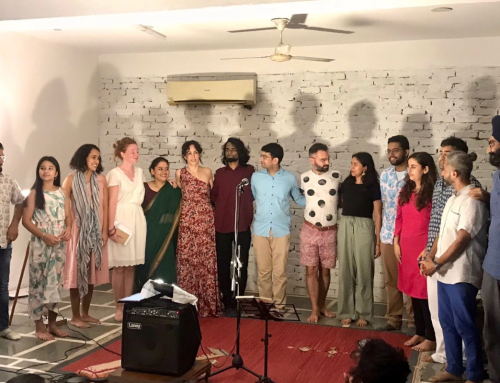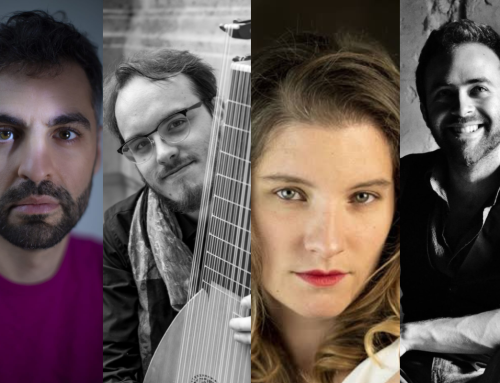Curated and Designed by Ankita Naik, Taashi Sharma, Akash Gadamsetty | 30th June 2022
We spent a beautifully balmy afternoon chatting with Akash Gadamsetty, faculty of the Yoga and Breathing course at Lilanoor. He graciously offered us a glimpse into his intimate journey with yoga and breathing. For the course at Lilanoor, he has curated and handpicked small moments from this life-altering journey, to make it more accessible and tangible for us to learn from. This interview however goes far beyond the ambit of the course, and delves into how yoga can transform one’s spiritual, bodily, emotional and organisational self and what it truly means to be joyous.
How did you get into Yoga?
Yoga has been an introspective journey, which I chanced upon when I had gone through a phase in life and was trying to get into a certain state of mind. Throughout childhood, my father had been pushing me into meditation but I was sceptical; my constant concern was – “How is just sitting down going to help with anything?”. When I actually found yoga later in life, I realised that the things I wanted to fix were not outside but inside me. Yoga seemed to be the perfect answer. Initially for me, it was only a mental process, not a physical asana oriented activity. I learnt with time that yoga was about how our thought process works and how we identify with each other. 2017 was the first time I got initiated into the practice of yoga and I went into a program. After completing the program I slowly began delving into it full time. There was even a time when I quit my job and moved to a yogashram in Coimbatore for about 7 months. That’s when I found how yoga might work in someone’s life.
What did you discover? How does yoga impact one’s life?
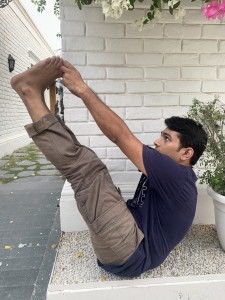 I had always heard people say that yoga is something that’s healthy for the body, healthy for the mind, spirit etc. But I found it difficult to rationalise concepts like the spirit. I also came across several books which said that yoga is about connecting with the soul but I couldn’t ever define these concepts. For me, yoga wasn’t ever primarily about health or the mind, but rather a tool to dissect the human mechanism to its finest level.
I had always heard people say that yoga is something that’s healthy for the body, healthy for the mind, spirit etc. But I found it difficult to rationalise concepts like the spirit. I also came across several books which said that yoga is about connecting with the soul but I couldn’t ever define these concepts. For me, yoga wasn’t ever primarily about health or the mind, but rather a tool to dissect the human mechanism to its finest level.
Just doing certain practices changes the way you function. Gradually, I observed changes in my lifestyle – sleep timings, daily patterns, and appetite. My daily sleep quota went down from almost 9 hours to around 5.5 hours in a matter of a month and a half. I could wake up without an alarm. On waking up, I used to do 2-3 hours of sadhana everyday…..we call it Sadhana – whatever practices we do.
I had volunteered for a project called Rally For Rivers – physically involving me in activities like organic farming, manual work etc but the body never felt tired. We just had 2 meals a day which turned out to be very beneficial for the system – i realised that once your stomach is full, the mind isn’t working at the fullest concentration capacity. So the meals were planned in a way with brunch at 10.30 am and then the next full meal at 7.30 in the evening. So essentially, we worked all day on an empty stomach, but there was no lethargy in the system. I also didn’t have to look at the food to gauge what it would do to my body. I gained a certain level of sensitivity about the impact of food on my body, the optimum quantity to be consumed etc.
As yoga works on the human body and mind in its entirety, the benefits I derived from it went beyond the body and voice. Even my mind got organised to such a level that the work which originally took me 6 hours, I was now finishing in 1.5 hours. That is an immense change in one’s organisational capabilities. I never knew that the mind can be trained to such levels. And that is just the beginning. You can delve so much more into it.
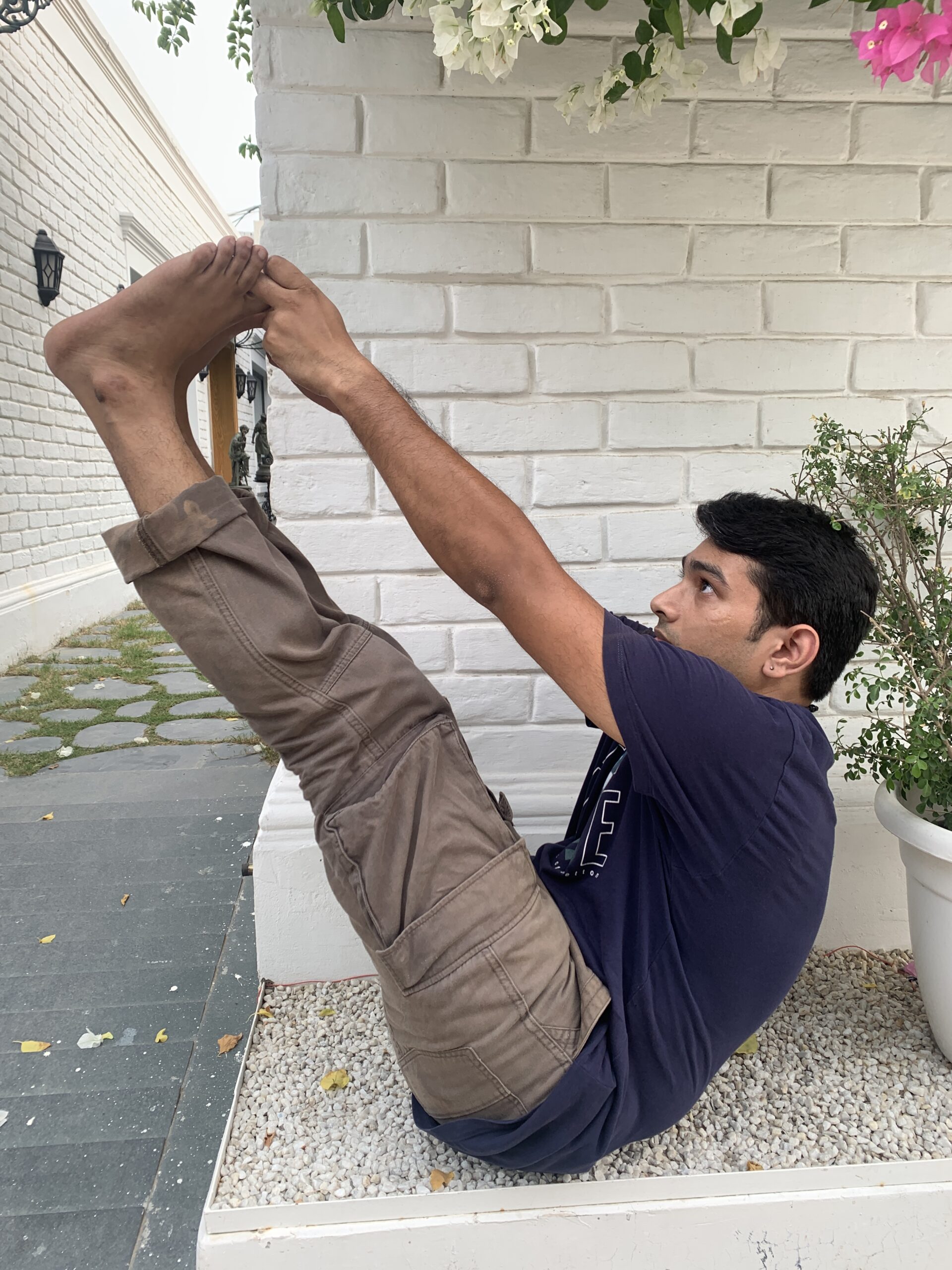
I had always heard people say that yoga is something that’s healthy for the body, healthy for the mind, spirit etc. But I found it difficult to rationalise concepts like the spirit. I also came across several books which said that yoga is about connecting with the soul but I couldn’t ever define these concepts. For me, yoga wasn’t ever primarily about health or the mind, but rather a tool to dissect the human mechanism to its finest level.
Just doing certain practices changes the way you function. Gradually, I observed changes in my lifestyle – sleep timings, daily patterns, and appetite. My daily sleep quota went down from almost 9 hours to around 5.5 hours in a matter of a month and a half. I could wake up without an alarm. On waking up, I used to do 2-3 hours of sadhana everyday…..we call it Sadhana – whatever practices we do.
I had volunteered for a project called Rally For Rivers – physically involving me in activities like organic farming, manual work etc but the body never felt tired. We just had 2 meals a day which turned out to be very beneficial for the system – i realised that once your stomach is full, the mind isn’t working at the fullest concentration capacity. So the meals were planned in a way with brunch at 10.30 am and then the next full meal at 7.30 in the evening. So essentially, we worked all day on an empty stomach, but there was no lethargy in the system. I also didn’t have to look at the food to gauge what it would do to my body. I gained a certain level of sensitivity about the impact of food on my body, the optimum quantity to be consumed etc.
As yoga works on the human body and mind in its entirety, the benefits I derived from it went beyond the body and voice. Even my mind got organised to such a level that the work which originally took me 6 hours, I was now finishing in 1.5 hours. That is an immense change in one’s organisational capabilities. I never knew that the mind can be trained to such levels. And that is just the beginning. You can delve so much more into it.
Apart from these effects on your lifestyle, how is this practice significant for a music school or for vocal technique?
So just to provide some context – in the midst of this immersive yoga experience, I hadn’t practised music at all in the ashram. But when I came back, my voice was two times larger than it used to be! I didn’t know how it had happened! My teacher was so surprised and asked me if I practised a lot but I hadn’t! I couldn’t answer how my voice had grown . Later on, when we started discovering and practising breathing techniques in singing, I found that a lot of them were somehow linked to all the yoga I had done because of their common focus on opening up the back, putting flexibility in the body etc.
In fact, singing without stress is about building both the necessary strength and flexibility at the same time. If you tighten any muscle in the system, the voice is affected. Yoga is the same – you learn to sit in postures and you’re intensely still. Usually we associate intensity with an immense amount of action but intensity can be everywhere – even in silence and stillness.
I learnt through physical yoga that in order to reach that stage of complete stillness with intensity, you need to work your body a lot. The same is what happened with me, in singing – you keep on training your lower back to stretch, your ribcage to open up – all of which requires strength, which is especially needed in opera. So the significant overlap in both is that if you put in a certain amount of pre-work, you reach a point of effortlessness.
I found that these parallels between the two could help my singing. I started integrating them – using surya kriya and yoga asanas with the breathing exercises for the voice – and there were so many similarities in a lot of exercises.
At a given point I was doing 6 hours of hata yoga everyday – which included kriya, yoga and also work. The ashram I was in, has been built carefully – there are certain energy spaces. They don’t feel how normal spaces feel – the moment you step in, it’s a transformative experience. It’s like getting into a room that you have built for yourself – in terms of your personality and your presence. You immerse yourself into it fully.
So this immersive long term experience at the ashram – how does it translate into an effective short term module at Lilanoor?
There are many exercises that I have shortlisted, and the module at Lilanoor is designed in such a way that initially people who come into it, are able to physically see some basic changes in the body – a little more agility, more flexibility. And if they stick to it long term then depending on each individual – they begin to see the same long term benefits that I observed in myself.
This is one of the reasons why I prefer teaching this course one on one, so I can mould the syllabus specifically for each person to yield long term benefits instead of a standardised module imparted to 2000 people at the same time. Mass training can be done but has its limitations. Instead, how I want to translate my experience is through a focused customised approach for the students. And as they stick to it, layer by layer, more stages and nuances are added that lead a person to a deeper and deeper state of understanding how they can use the body and breath for music and for life in general.
An amazing school with accomplished, experienced and talented teachers. This school is a one stop shop if you want to learn to sing. Everything from breath work to technique is taught here. Can’t recommend it enough!
Why is the course ‘Yoga And Breathing’ – and not just yoga?
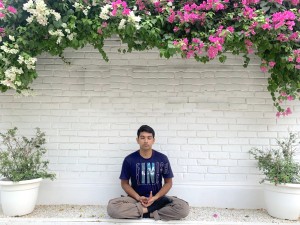 This module does not contain just yoga – it has a lot of elements of vocal perspective breathing in it – for you to experience breathing in its fullest. So when you go to a voice lesson, you’re halfway ready with the breathing techniques already and then your teacher can fine tune it.
This module does not contain just yoga – it has a lot of elements of vocal perspective breathing in it – for you to experience breathing in its fullest. So when you go to a voice lesson, you’re halfway ready with the breathing techniques already and then your teacher can fine tune it.
So for the first 3 months I walk you through hand-picked exercises – they’re more physical, involving asanas – and then gradually it transitions into meditative experiences. On starting most things, usually people ask – What is the use of it? How can it be used? To gain that initial sense of satisfaction and an answer to that question, I believe it’s important to first get to the utility of something and then look beyond it. So in this module too, we first give students small practices whose usefulness is more immediately visible and then slowly those exercises itself will be used to get into a state of mind to tap into other depths as a person.
This module eventually helps get to a better general level of productivity in life. It makes way for a more joyous way of living – not necessarily in the sense of “Oh I’m so happy all the time” but perhaps more in terms of the 20-30 minutes of practice being therapeutic and bringing about the thought that “this is one thing that helps me go on”. In these 30 mins you’ll naturally come to a place of relaxation. So I’m definitely not offering solutions to life but a way to make one feel a bit better.
How much of this course is related to the body and how much of it is breathing?
I don’t see the both of them as separate things. If the question is about how much arms and legs will you move, I can tell you that the movement itself won’t be as much as the breath work. And even in movement activities where there are elements of flexibility etc, the focus is on the breath. Because every single movement of the body is based on how we breathe. So, in terms of exercises, I’d say around 30% is physical body exercises.
Is the course suitable for all age groups?
Right now the module I have is for 14+ years. For children, I feel, there is less of a need to teach meditation per se. We can teach them breathing techniques for focus etc, but specific yogic practices are not needed for a young age.
What are some of your inspirations that you’ve taken from?
In my understanding, there are four very basic categories of yoga – gnana, bhakti, karma and kriya – they talk about 4 dimensions of a human being – intellect, emotion, physical body and internal energies.

There is a yogic lore behind this – One day, the four practitioners of these branches are walking together in a forest and are naturally not thrilled about being in each other’s company – given their conflicting and contrasting views on the practice. Suddenly there is a huge rainstorm and it becomes increasingly dangerous to stay out. So they run to a space and find a temple in the middle of the forest. They enter the temple- but the sanctum sanctorum is the only area with a shelter and it is extremely small. So they huddle up and latch onto each other – and the moment they do so, God appears. They all get angry and exclaim – “All my life I’ve been relentlessly practising yoga and could never see you. Why did you appear right now?”. To this, God responds, I have been trying to get the four of you together since your inception and now that you’re finally together, here I am!
The significance of this lore is that there are four faculties within us and the point of yoga is to get all four of them completely focused in one direction. I’ve tried several schools of yoga and breathing – the Isha Foundation, The art of living, Divine life Society, Brahma Kumaris, Aurobindo Ashram, Sahaja yoga, Nityananda and I have picked up something beneficial from each. My experience is of course specific to my own context and state of mind and the timing of it, but to me each of these schools of thought have powerful insights and practices to offer and I’ve tried my best to incorporate the elements into the course at Lilanoor.
AKASH GADAMSETTY

Akash Gadamsetty started singing at a very early age but his real journey of music started when he discovered Western Classical Singing in 2015 at The Neemrana Music Foundation where he started training under Mr. Jasmin Martorell and then moved to Paris in 2019 where he completed his course in Lyrical Singing under Ms. Nathalie Spinosi.
He has performed in several productions of the Neemrana Music Foundation (El Retablo De Maese Pedro, La Vida Breve, La Republica Del Amor etc) at various venues (Lotus Temple, India International Centre, Alliance Française Delhi, Jawaharlal Nehru Stadium and Royal Opera House In Mumbai…).
He has also been training under Mr. Jasmin Martorell for Vocal Pedagogy since 2016 and has been teaching at several institutions across Delhi NCR since 2017.
Playlist
Here is a collection of songs that you can listen to for relaxation. However while practising yoga and breathing, we recommend total silence.
Lilanoor Monthly Puzzle
How familiar are you with yoga terminology? This crossword is for those who want to stretch their minds along with their backs. Feel free to use Google.
You can enter your answers on the screen itself!
Created through https://crosswordlabs.com
Across
6. An essential involuntary/voluntary action in the body. [9]
7. The third energy junction from bottom to top along the spinal cord. [10]
9. Author of the Yoga Sutras. [9]
10. The fifth element; Also the name of our faculty member of Yoga & Breathing. [5]
11. Muscle in the body that helps you breathe. [9]
12. An internal action for transforming energies. [5] 13. An ancient school of thought originating in Mount Kailash, Tibet, that focuses on building up the human system up to its fullest potential. [4]
Down
1. A deep state of meditativeness, that Gautama Buddha initiated his close disciples into. [6]
2. Junction of energy nodes in the body. [6]
3. Method of using breath for yoga. [9]
4. A new space for the arts to come together that focuses on discipline, skills and understanding the aspects of being a vocalist across genres.; 389 Masjid Moth. [8]
5. To focus one’s mind into contemplation, mindfulness, mindlessness or just relaxation for a period of time. [8]
8. Corpse pose. [8]
10. Eight path system of yoga, popularised in the modern times by K Pattabhi Jois. [8]
Answers to the Puzzle
Across
6. Breathing
7. Manipuraka
9. Patanjali
10. Akash
11. Diaphragm
12. Kriya
13. Yoga
Down
1. Shunya
2. Chakra
3. Pranayama
4. Lilanoor
5. Meditate
8. Savasana
10. Ashtanga

